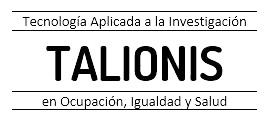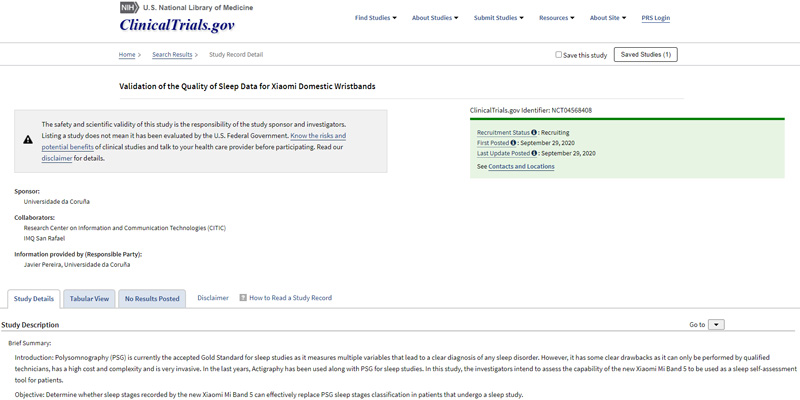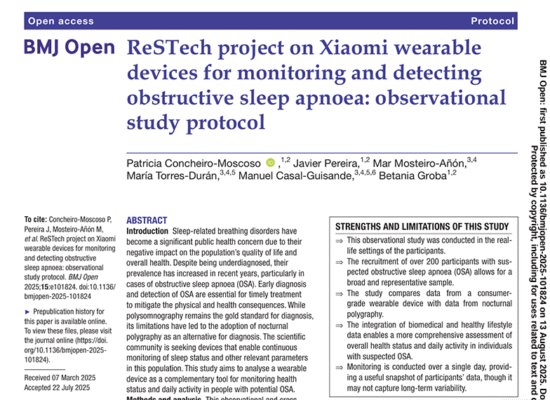ClinicalTrials.gov Identifier: NCT04568408
Validation of the Quality of Sleep Data for Xiaomi Domestic Wristbands
Introduction: Polysomnography (PSG) is currently the accepted Gold Standard for sleep studies as it measures multiple variables that lead to a clear diagnosis of any sleep disorder. However, it has some clear drawbacks as it can only be performed by qualified technicians, has a high cost and complexity and is very invasive. In the last years, Actigraphy has been used along with PSG for sleep studies. In this study, the investigators intend to assess the capability of the new Xiaomi Mi Band 5 to be used as a sleep self-assessment tool for patients.
Objective: Determine whether sleep stages recorded by the new Xiaomi Mi Band 5 can effectively replace PSG sleep stages classification in patients that undergo a sleep study.
Methods and analysis: the study will be carried out with patients in a hospital from A Coruña (Galicia, Spain) that are > 18 years old. Patients who are performed a polysomnography test will be given the wearables so the investigators can record sleep stages with both techniques in order to compare both recordings afterwards.
This is an observational, analytic and longitudinal study. In other words, in this study different variables from the population of interest will be observed and recorded without any direct intervention, so as to establish causality associations between these variables. It is considered as longitudinal since a six-months tracking of the variables will be performed, continually (and sometimes occasionally) recording and monitoring sleep quality (wearable wristbands).
The data obtained from PSG and Xiaomi Mi Band 5 will be preprocessed and explored before extracting the features of interest for the study. Then, Paired sample T-Test will be performed to compare the means among the different variables, Bland-Altman plots will be used to assess the concordance between both techniques and, finally, Epoch by Epoch analysis will be performed to compare the classification of the sleep stages carried out by both PSG and Xiaomi.
| Condition or disease | Intervention/treatment |
|---|---|
| Sleep Disorder | Device: Xiaomi MiBand 5 |
Introduction: Sleep disorders are becoming a widespread health problem within the general population. Beyond the tiredness itself, these disorders have been found to be related to physical and mental issues like cardiovascular pathologies, obesity, depression and anxiety. This makes clear the necessity of achieving a quality rest to prevent potential chronic diseases. On this issue, Polysomnography (PSG) is currently the accepted Gold Standard for sleep studies as it measures multiple variables that lead to a clear diagnosis of any sleep disorder. However, it has some clear drawbacks as it can only be performed by qualified technicians, has a high cost and complexity and is very invasive. In the last years, several studies that focus on validating wearable devices as useful sleep trackers have emerged. In this study, the investigators intend to assess the capability of the new Xiaomi Mi Band 5 to be used as a tool for sleep self-assessment for patients. The interest in studying this smartband is due to its low price and acceptance among the population. If this device proves to be a good sleep tracker, it would allow the population to assess their own sleep and consider if they need to visit their medical practitioner, which would improve the prognosis of any underlying condition they may be developing derived from their restlessness.
Objective: Determine whether sleep stages recorded by the new Xiaomi Mi Band 5 can effectively replace PSG sleep stages classification in patients that undergo a sleep study. The following features will be calculated for both devices: total sleep time, sleep efficiency, sleep latency and wake after sleep onset. Sleep stages will also be recorded.
Methods and analysis: the study will be carried out with patients in a hospital from A Coruña (Galicia, Spain) that are > 18 years old. Patients who are performed a polysomnography test will be given the wearables so the investigators can record sleep stages with both techniques in order to compare both recordings afterwards.
This is an observational, analytic and longitudinal study. In other words, in this study different variables from the population of interest will be observed and recorded without any direct intervention, so as to establish causality associations between these variables. It is considered as longitudinal since a six-months tracking of the variables will be performed, continually (and sometimes occasionally) recording and monitoring sleep quality (wearable wristbands).
The data obtained from PSG and Xiaomi Mi Band 5 will be preprocessed and explored before extracting the features of interest for the study. Then, Paired sample T-Test will be performed to compare the means among the different variables, Bland-Altman plots will be used to assess the concordance between both techniques and, finally, Epoch by Epoch analysis will be performed to compare the classification of the sleep stages carried out by both PSG and Xiaomi.





